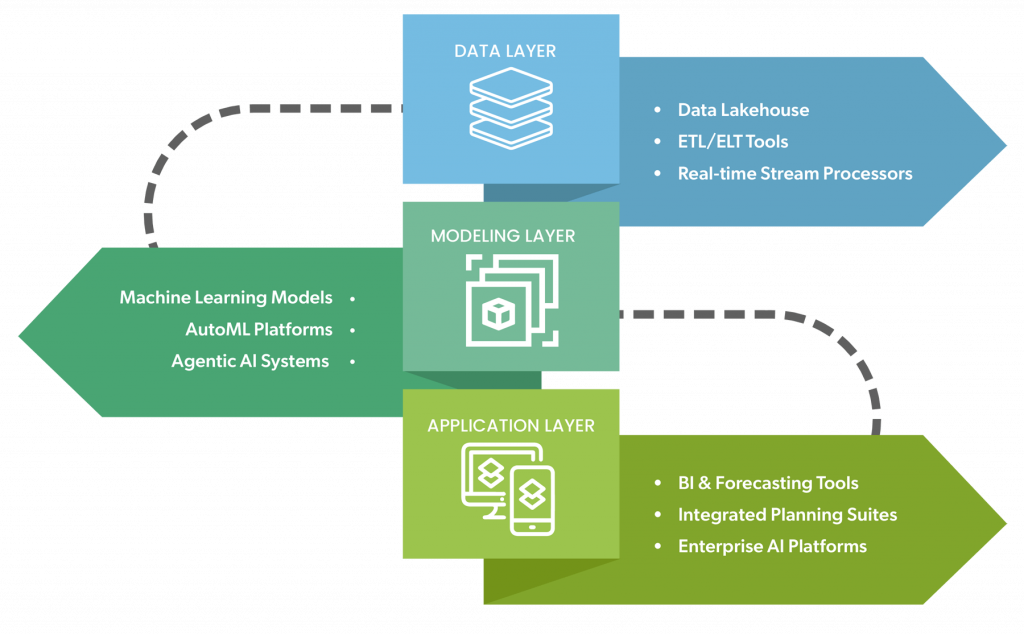Here’s What You Will Learn in This Blog
- What is Predictive AI in Enterprise Planning?
- The Technical Stack Behind Predictive AI
- Agentic AI: The New Dimension in Enterprise Planning
- Key Functional Areas Transformed by Predictive AI
- Scaling Predictive AI with the Right AI Strategy
- Real-World Application: A Predictive AI Use Case
- Interconnected Learning: Related Reads
- Conclusion
From Reactive Guesswork to Proactive Precision
Enterprise planning has traditionally been a slow-moving, quarterly ritual based on backward-looking data, static spreadsheets, and human intuition. But in a volatile business environment where change is constant, those methods are no longer viable.
Enter Predictive AI – a powerful, forward-facing intelligence layer that uses machine learning algorithms, real-time data streams, and advanced models to forecast outcomes, optimize decisions, and automate planning across finance, operations, HR, and supply chain functions.
In this article, we explore how predictive AI reshapes enterprise planning, the underlying technologies that enable it, and the strategic roadmap required to scale AI adoption successfully.
What is Predictive AI in Enterprise Planning?
Predictive AI applies statistical algorithms, historical data, and real-time signals to predict future events with a quantifiable confidence level. Unlike traditional forecasting, which is rule-based, and largely linear, AI-based planning systems adapt continuously by learning from new inputs.
These models feed into AI platforms integrated within a company’s data ecosystem – often combining ERP, CRM, and external data sources into a unified architecture like Data Lakehouse.
The Technical Stack Behind Predictive AI

Data Layer
- Data Lakehouse (Delta Lake, Snowflake, BigQuery) – Centralized storage combining data warehouse governance with data lake flexibility
- ETL/ELT Tools – dbt, Talend, Fivetran for transforming data into model-ready formats
- Real-time Stream Processors – Apache Kafka, Flink for feeding live signals (e.g., POS data, IoT, clickstream)
Modeling Layer
- Machine Learning Models – Time-series (ARIMA, Prophet), XGBoost, LSTM Neural Nets
- AutoML Platforms – Google Vertex AI, H2O.ai, DataRobot
- Agentic AI Systems – Intelligent AI agents that autonomously analyze datasets, test forecasting scenarios, and suggest planning actions
Application Layer
- BI & Forecasting Tools – Tableau, Power BI, SAP Analytics Cloud
- Integrated Planning Suites – Anaplan, Oracle Cloud EPM, SAP IBP
- Enterprise AI Platforms – Nsight’s integrated AI planning framework that connects models, workflows, and stakeholders
Agentic AI: The New Dimension in Enterprise Planning
While most predictive AI systems are model-driven, Agentic AI introduces a layer of autonomy – allowing AI agents to independently:
- Assess data quality and gaps
- Run simulations across multiple planning scenarios
- Trigger automated alerts or planning updates
For example, in a supply chain scenario, an AI agent might detect a supplier disruption based on external news feeds, run simulations to identify optimal alternatives, and trigger a real-time reforecast across operations and procurement.
This reduces human intervention, improves response speed, and drives proactive planning cycles.
Key Functional Areas Transformed by Predictive AI
1. Financial Planning and Forecasting
Traditional FP&A cycles rely on fixed budgets that break under market volatility. Predictive AI enables:
- Real-time cash flow forecasting
- Variance detection using anomaly models
- Profitability modeling across pricing, cost, and demand variables
Tool stack: SAP Analytics Cloud (Predictive Planning), Python (Prophet models), Excel + Power Query + AI add-ons
2. Supply Chain Forecasting
AI models use demand signals, seasonal patterns, and external disruptions (weather, geopolitical events) to optimize:
- Inventory levels
- Lead-time buffers
- Logistics routing
Technical foundation: Time-series ML models (LSTM), data fusion from IoT + ERP (e.g., SAP IBP + AWS IoT)
3. Sales & Marketing Forecasting
Predictive analytics refines targeting strategies and improves sales pipeline accuracy using:
- Buyer intent models
- Predictive lead scoring
- Personalization using content intelligence
AI solutions used: Salesforce Einstein, HubSpot Predictive Lead Scoring, Nsight AI + CRM connectors
4. Workforce Planning
HR leaders use AI to project workforce needs and predict attrition with:
- Attrition modeling using logistic regression or decision trees
- Capacity planning aligned with project forecasts
- AI-powered skill gap assessments
Tooling: Oracle HCM Cloud + ML add-ons, People Analytics from SAP SuccessFactors, Power BI + Azure ML integration
Scaling Predictive AI with the Right AI Strategy
Enterprise AI success hinges not only on models and platforms—but on a scalable AI strategy that addresses the following:
Governance
- Data privacy, ethical model usage, and regulatory compliance
- MLOps pipeline management to ensure traceability and version control
Model Development
- Modular architecture to support diverse planning models (sales, finance, ops)
- Feedback loop between predictions and actuals to retrain models
Change Management
- User training and trust-building in AI recommendations
- Executive sponsorship + business stakeholder alignment
Real-World Application: A Predictive AI Use Case
A global logistics firm partnered with Nsight to deploy a predictive AI solution for fleet utilization forecasting. By integrating:

… they reduced downtime by 18% and increased route accuracy by 22%, delivering significant cost savings within 3 months.
Interconnected Learning: Related Reads
Want to understand foundational tools?
AI Predictive Analytics: Leveraging Tools for Business Insights »
Curious about the difference between forecasting and predictive modeling?
Forecasting vs Predictive Models: Key Differences (Coming soon)
Conclusion: AI-Driven Planning is Not Optional-It’s Inevitable
In a high-velocity business landscape, companies that continue to rely on static planning cycles will fall behind. Predictive AI, powered by robust data architectures and advanced model orchestration, is becoming the new baseline for competitive strategy.
By integrating intelligent AI agents, cloud-native planning platforms, and a continuous learning loop, enterprises gain the ability to plan ahead—not look back.
Let your infrastructure work for you-intelligently, automatically, and in real time.
About the Author

Deepak Agarwal, a digital and AI transformation expert with over 16 years of experience, is dedicated to assisting clients from various industries in realizing their business goals through digital innovation. He has a deep understanding of the unique challenges and opportunities, and he is passionate about using cutting-edge technologies to solve real-world business problems. He has a proven track record of success in helping clients improve operations, increase efficiency, and reduce costs through emerging technologies.





